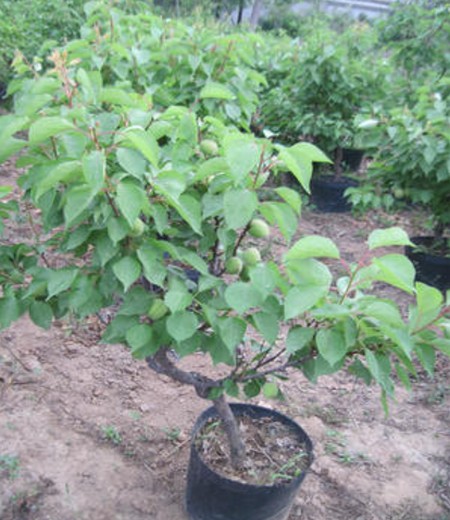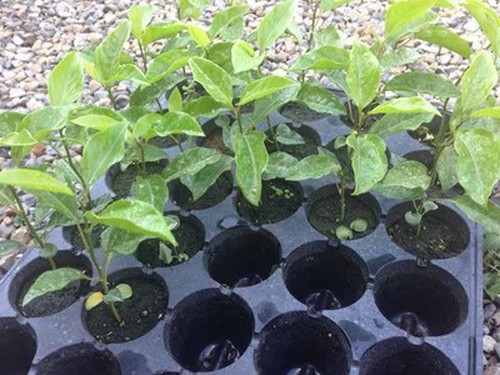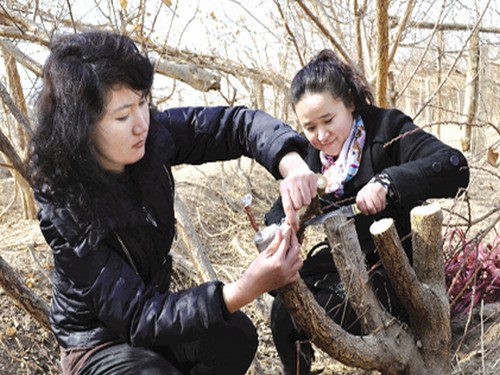Planting methods and matters needing attention of apricot trees
Apricot fruit ripens early, has high nutritional value, is suitable for processing and raw food, and occupies an important position in the early spring fruit market. From the domestic and foreign markets in the past ten years, apricot fruit is in short supply, the price is rising steadily, and the economic benefit is high, so it is a promising tree species.

Apricot is one of the main fruit tree varieties in southern Xinjiang. If apricot trees are not managed properly, it will cause problems such as tree weakness, poor quality, frequent occurrence of diseases and insect pests and so on. In the past two years, the varieties of apricot trees in the village of Bao Zihong Bashi have deteriorated, the quality of the harvested apricots has declined, and they cannot sell at a good price, causing worries to the local growers. In order to solve this problem, the reporter interviewed Zhang Ping, a researcher and director of the Agricultural products Storage and processing Institute of the Academy of Agricultural Sciences, who introduced to the reporter the key technologies for high quality and high yield of apricots.
First of all, we should select excellent varieties and match them with pollinated varieties. "Sebuti apricot", "Muge apricot", "black leaf apricot", "star apricot" and "Xiaobai apricot" are all excellent apricot varieties in southern Xinjiang. if inferior varieties are found in apricot orchards, high grafting should be carried out in time. In order to improve the fruit setting rate, pollinated varieties should also be matched. Generally, the ratio of main varieties to pollinated varieties is 1 ∶ 2 to 1 ∶ 4, so as to prevent the low fruit setting rate caused by a single variety. The shape of the tree should be ventilated and transparent, and apricot trees generally choose the shape of natural round head. There is no obvious central leader trunk in this tree shape, the stem height is generally 60 cm to 100 cm, and 4 to 5 main branches are retained, which are staggered and arranged on the central leadership trunk. One side branch is left on the main branch every 40 cm to 60 cm, and the lateral branch is equipped with branch groups. large branch groups can also be used instead of lateral branches. The height of the tree should be controlled between 3.5 m and 4.5 m.
Secondly, we should pay attention to the management of soil and fertilizer. The general width of the planting ditch is about 1 meter. The ditch is covered with plastic film or is often ploughed, loosened and weeded to keep the soil loose and weed-free.
The base fertilizer is mainly farm manure, which is applied after apricot harvest. "the way of applying base fertilizer is determined according to the planting situation of each local family." Zhang Ping said. One-year-old to three-year-old apricot trees were applied by burrowing, digging 40cm × 40cm × 50cm holes in different directions, applying farm manure 2 to 3 cubic meters per mu, and ditching for more than 4-year-old trees. 50 cm wide and 50 cm deep, 3 to 5 cubic meters per mu. Apricot trees should be topdressing four or five times a year, before flowering, urea 10 kg to 20 kg per mu, diammonium phosphate 5 kg per mu, hard core stage 25 kg per mu, potassium sulfate 20 kg per mu, combined with base fertilizer after harvest, diammonium phosphate 20 kg per mu. "when topdressing, dig holes in different directions at the periphery of the crown projection, with a depth of 20 cm to 30 cm, and irrigate immediately after fertilization." Zhang Ping stressed. Irrigation was done once in sprout or flowering stage, expansion stage, hard kernel stage, after harvest and in winter. Foliar fertilizer spraying should be selected in the morning or evening of the apricot fruit expansion period, commonly used 0.3% urea or 0.5% potassium dihydrogen phosphate and so on, with an interval of 10 to 15 days, three times in a row.
Gummy disease, shell insects, aphids and solid insects are all common diseases and insect pests in Bao Zihong Bashimali village. Tree trunks and branches suffering from gum disease shed transparent gum in spring, which is mostly caused by tree weakness, frostbite and insect injury. Therefore, it is necessary to strengthen the fertilizer and water management and plastic pruning of apricot trees. 1 kg sulfur powder + 10 kg quicklime + 40 kg water + a small amount of clay or cement can be used to whiten tree trunks and main branches in winter. The whole tree should be evenly sprayed with 5-degree stone-sulfur mixture before sprouting in spring. Scale insects produce 1 to 2 generations a year and spray 5-degree stone-sulfur mixture before sprouting in early spring. At the beginning of August, 1000 times of chlorpyrifos were sprayed at the peak of nymph spread, and the safe interval was 30 days. Aphids mainly harm young shoots and leaves, which curl to the back and curl up in severe cases, which stagnates the growth of new shoots. Combined with pruning, the branches with eggs are cut off. Spray 0.5% veratrine alcohol solution 400 to 600 times dilution before rolling leaves. During the period of heart borer control, based on the monitoring of local agricultural or plant protection departments, green bionic agents or biological agents are mainly adopted, such as 0.5% veratrine alcohol solution for uniform spraying. Or 1% matrine soluble solution 800 to 1200 times uniform spray.
Harvesting is also critical as the last step before apricot is sold. Harvesting and selection should be carried out after the dew dries in the sunny morning, and different varieties should be harvested and transported separately. For dried apricots, 80% to 9% of the fruits should be harvested. Apricots with a slightly higher temperature in southern Xinjiang, which are used for fresh food, should be transported to the market in time after harvest or refrigerated, stored and transported gently during picking, and it is appropriate to keep the fruit handle with scissors. The harvesting container should be clean with a capacity of 10 kg to 15 kg.
[notes]
Planting: select seedlings with good root system, strong and substantial branches, reaching a certain height and thickness, and no serious diseases and insect pests and mechanical damage. Apricot trees can be planted in spring and autumn. the suitable period for planting apricot trees in spring is from the thawing of soil in early spring to the middle of April, and from defoliation to freezing in autumn.
Fertilizer and water: irrigate at least once before sprouting, after flowering, in autumn and before soil freezing. Irrigation and topdressing can be carried out at the same time. If you encounter a year with a lot of rainfall, you should pay attention to the drainage and waterlogging prevention of apricot orchard. Base fertilizer is given to people before the leaves fall. Topdressing applied human available nitrogen combined with phosphorus and potassium fertilizer before sprouting and fruit expansion period; after fruit picking, topdressing mainly applied phosphorus and potassium fertilizer, a small amount of nitrogen fertilizer; after fruit picking, the combination amount of nitrogen fertilizer could be increased appropriately.
Pruning: young trees are highly dry in shaping and pruning apricot trees, so it is appropriate to adopt the natural happy shape of multiple main branches. Results the pruned apricot trees in the initial stage can blossom and bear fruit 3 years after planting, and the growth potential of branches in this period is still very strong. Its pruning of 0 is to continue to expand the crown, maintain the necessary tree shape, and cultivate as many fruiting branches as possible. The fruiting part moved outward in the middle and later stage of the full fruit stage, and the branches in the lower part of the crown began to be bald, so the main task of pruning in the full fruit period was to adjust the relationship between fruit and growth, keep the tree strong and prolong the full fruit period. In the aging period, the main task of pruning apricot trees is to rejuvenate, renew and re-cultivate fruiting branches. The specific pruning method is to aggravate the retracted and weak perennial branches, stimulate latent buds to sprout vigorous branches, and choose to cultivate new backbone branches, extended branches and fruiting branches.
Harvest: after fruit harvest, apricot trees need to open the corners of young and prosperous branches to ease the tree potential and promote flower formation. The second coring of the new shoots was carried out to promote the branching and cultivate the branch group. Cut off the growing branches, disease and insect branches in time. The branches of diseases and insect pests were centrally burned.
Time: 2019-05-25 Click:
- Prev

Planting technique of passionflower (passion fruit)
Passionflower, also known as passion fruit, is a perennial vine that has no erect trunk and fixed tree shape and grows by climbing trees or other objects under natural conditions. Passionflower is a tropical fruit tree, which is not cold-resistant and likes light and high temperature. it is planted in the mountains of northern Guangdong and is cultivated seasonally.
- Next

Grafting technique of apricot tree
In recent years, with the promotion of apricot hot air drying room drying project in the three prefectures of South Xinjiang, the enthusiasm of the masses in South Xinjiang for planting apricot trees is getting higher and higher. The villagers of Suyitika Village, which has been planted for many years, are also seizing this opportunity to vigorously develop apricot industry, but the villagers are in urgent need of apricot grafting technology.
Related
- Fuxing push coffee new agricultural production and marketing class: lack of small-scale processing plants
- Jujube rice field leisure farm deep ploughing Yilan for five years to create a space for organic food and play
- Nongyu Farm-A trial of organic papaya for brave women with advanced technology
- Four points for attention in the prevention and control of diseases and insect pests of edible fungi
- How to add nutrient solution to Edible Fungi
- Is there any good way to control edible fungus mites?
- Open Inoculation Technology of Edible Fungi
- Is there any clever way to use fertilizer for edible fungus in winter?
- What agents are used to kill the pathogens of edible fungi in the mushroom shed?
- Rapid drying of Edible Fungi

